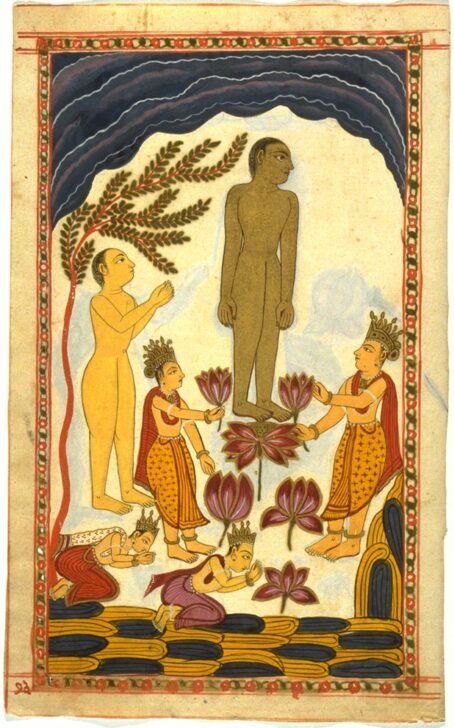Jina and a devotee from a Digambara Jain manuscript
Indian

Description
Gallery Rotation Winter 2012
left
Jina and a devotee from a Digambara Jain manuscript
India, Rajasthan, Sirohi School
ca. 18th century
Ink, opaque watercolor, and gold on paper
Gift of Dr. and Mrs. Leo S. Figiel and Dr. and Mrs. Steven J. Figiel, 1975/2.174
right
Jina and devotees from a Digambara Jain manuscript
India, Rajasthan, Sirohi School
ca. 18th century
Ink, opaque watercolor, and gold on paper
Gift of Dr. and Mrs. Leo S. Figiel and Dr. and Mrs. Steven J. Figiel, 1975/2.175
Jains highly revere the written word—one day of the liturgical year is even set aside to worship texts—and before the era of the printed book it was customary for a lay donor to commission a handwritten manuscript for presentation to a spiritual teacher and ultimately to the temple library. Indeed arranging for manuscripts to be copied for monks to use was expected of the laity as part of their support for and devotion to the monastic community. Monks and nuns were themselves discouraged from practicing the art of painting: one text expressly warns of the power of painting to arouse sensual feelings. Beholding a book, however, was believed to help the individual achieve the proper mental state for spiritual guidance.
These illustrations are from a famous Jain hymn. In the one on the left we see the Jina (or enlightened Jain teacher) standing on a lotus. The monk Manatunga stands to his side, his hands folded in worship, while two gods offer more lotuses. The hymn verse associated with this illustration explains that wherever the Jina steps, the gods offer lotuses for him to tread on. In the illustration on the right, flowers surround the central Jina; they come from two gods seated in celestial vimanas or floating palaces at the top of the painting. The related verse tells us that the flowers are those of the heavenly wishing trees and are showered onto the Jina in worship.
Subject Matter:
In the Jain religion, the practices surrounding book production reflects the integral relationship among the laity, monastic community, and the Jina, or enlightened Jain teacher. It was customary for a lay donor to commission a copy of a text for presentation to his spiritual teacher and ultimately to the temple library; this fulfilled/thus fulfilling the lay obligation of charity. Over the centuries, monastic libraries received great quantities of texts, which were employed in the instruction of monks and nuns, who were themselves discouraged from practicing the art of painting: one text expressly warns of the power of painting to arouse sensual feelings. Beholding a book, however, was believed to help the individual achieve the proper mental state for spiritual guidance.
These manuscript illustrations are from a famous Jain hymn. In the one on the left we see the Jina [or enlightened Jain teacher] standing on a lotus. The monk Manatunga stands to his side, his hands folded in worship, while two gods offer more lotuses. The hymn verse associated with this illustration explains that wherever the Jina steps, the gods offer lotuses for him to tread on. In the illustration on the right, flowers surround the central Jina; they are dropped by/come from two gods seated in celestial vimanas or floating palaces at the top of the painting. The related verse tells us that these flowers are from/are those of the heavenly wishing trees and are showered onto the Jina in worship.
Physical Description:
Nude (Jina, center) and a devotees (nude on left, and other clothed figures) depicted in a folio of a Jain manuscript.
The image contains trees, lotus flowers and dark clouds. The the colors are composed of vivid reds, browns, yellows, greens and blues. The image is surrounded by a red and green pattereed border which resembles a chain.
Usage Rights:
If you are interested in using an image for a publication, please visit https://umma.umich.edu/request-image/ for more information and to fill out the online Image Rights and Reproductions Request Form.